All about spring lawn care
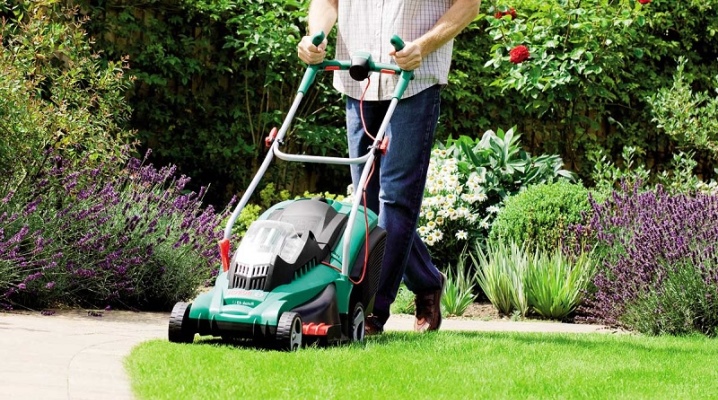
A beautiful green lawn is the pride of any summer resident. But in order to keep the lawn in good condition, every time after winter you need to feed it, treat it, repair it, and so on. We will tell you about what should be the care of the lawn in the spring in our article.
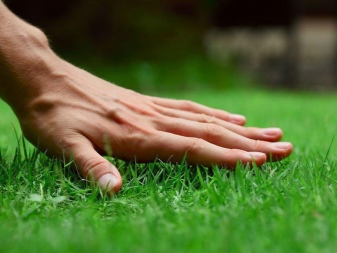

Peculiarities
Spring lawn care begins as soon as the snow melts. If you see an ice crust on the ground in the morning and evening, try to remove it from the lawn. To do this, arm yourself with a broom or a rake. During this period, the root system does not have enough air and it is very important to do such a purification in order to prevent the destruction of the roots. When the snow is melting, do not allow water to accumulate on the lawn. You can make holes in the ground so that it seeps out faster, free the lawn grass from fallen leaves along the way. All other activities are carried out after the soil has dried a little.
Preparing a rolled lawn after winter includes the same activities as for a conventional sowing cover. According to the standard scheme, rotten grass, straw, and other debris are removed, but in this case the movements should be more careful so as not to harm the roots, which are still in a weak state. When working with a rake, movements are made exclusively in the perpendicular direction.
In order for the roll covering to require less attention in spring, in winter it is not necessary to tamp the snow on it, shoveling it from another place and throwing it onto the lawn. As a result of such actions, the grass may be damaged, moreover, it will always be in the ice crust, which is undesirable to allow.
A feature of spring care for all types of lawns is the mandatory implementation of the following activities:
- combing the lawn;
- aeration;
- restoration;
- top dressing;
- watering;
- weed control;
- cutting grass.
Let's dwell on each action separately.
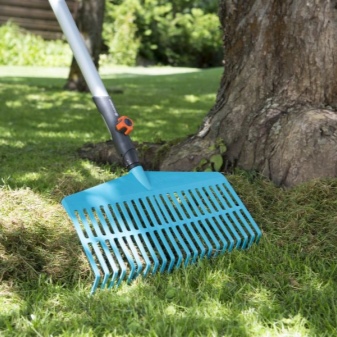
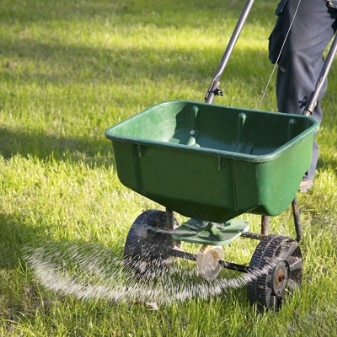
Combing out
You will need to comb the grass, but do not rush to pick up a tool (fan or ordinary rake, a special brush for cleaning, and so on). Brushing is carried out exclusively on dry soil and when the grass is also completely dry. Here are the basic guidelines for this process:
- before work on the lawn, it is necessary to carry out a general cleaning: remove fallen leaves, other debris;
- you can clean the lawn with your own hands using a fan or regular rake, it is preferable to use a fan, since ordinary ones can pull out plants, especially if the lawn is young;
- all caked grass is cleaned from the lawn and taken to a compost bin or collected in a heap for incineration.
If the area is large, a mechanical method of verticulation (combing) can be used. For these purposes, a technique such as a verticulator is used, which is a hollow cylinder and many thorns. Combing is compared to the first emergency lawn care after winter. In addition to cleaning, this procedure loosens the hardened surface crust. Well, the root system breathes easier, it gets full access to oxygen.
The grass comes to life every hour, and it is very important not to walk on the lawn for at least a week and a half after verticulation.
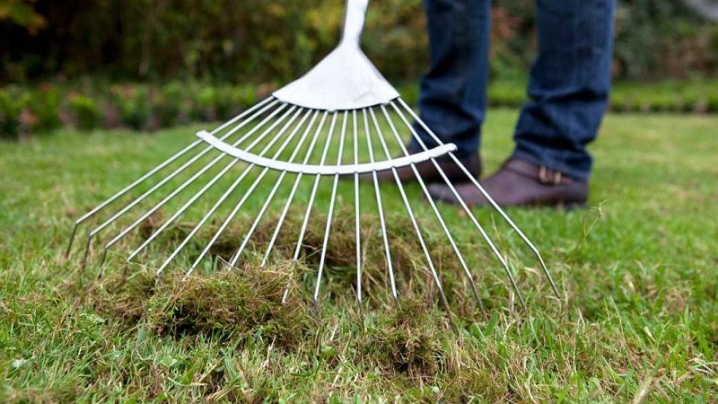
Aeration
To put the lawn in order, after combing out, aeration is carried out, during this process, the ground is pierced with special devices (verticutters, scarifiers) or pitchforks to different depths: a young lawn is pierced to a level of 3-5 centimeters, and an older coating is processed deeper - at a level of 10 centimeters.
The roots get direct access to air and begin to develop more intensively. There are versatile machines that can comb out the lawn and then aerate it.When the area is small, you can use a pitchfork (pierce it all the way, pressing like a shovel) or special sandals-aerators (shoes with nails).
In the latter case, a special attachment with pins in the form of nails is put on the shoes. In this form, children are very fond of doing this work. Starting in middle age, they can be trusted to walk in these boots on the lawn in the spring. If you are dealing with denser soil, do not limit yourself to aeration only in the spring.
Do this exercise several times per season, this will have a beneficial effect on the development of green cover and saturate the soil with oxygen.
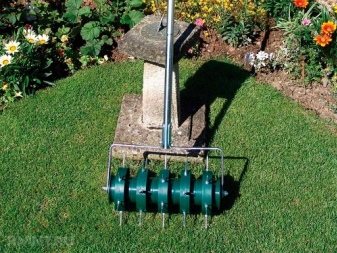
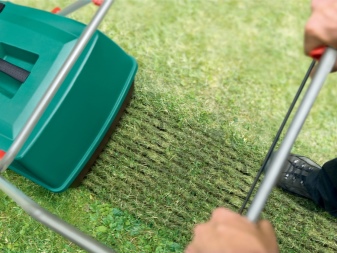
Top dressing
Top dressing should be an important part of spring lawn care. At this time, like other plants, the lawn needs to be fed with nitrogen-containing fertilizers. This will help the coating gain a good green mass. In the course of excavation, add ammonium nitrate or urea (urea). There are separate special mixtures for fertilizing lawns, you can use such complex formulations. They are brought in during the spring and summer seasons.
It is convenient to feed large areas with complex fertilizers of prolonged action. Having fertilized the lawn in this way once in the early spring, you do not need to return to such events either in summer or in autumn. Many gardeners prefer liquid fertilizers. If you strictly observe the proportions, there is less chance of burning the grass than when fertilizing with dry or granular formulations. In the latter case, abundant watering after feeding is important.
The best option is fertilizers that dissolve easily in water and are applied along with irrigation. They regulate the concentration of trace elements in the water, quickly reach the root system and are highly effective - the result of such feeding will be noticeable after a few days. It is important to distribute fertilizers evenly over the entire plot, otherwise the grass will germinate in some places, and in some it will be underdeveloped, and such a difference will be very noticeable.
To properly care for the lawn in this part, you can buy yourself special feeding devices. Caring for a rolled lawn (sowing) also includes feeding it with phosphorus and nitrogen, which will significantly stimulate the growth of grass in the spring. The lawn must be monitored regularly to prevent, on the one hand, the depletion of the sprouts, and on the other, excessive overgrowth of the site.
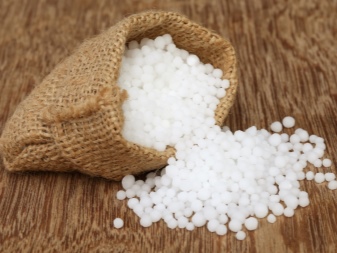
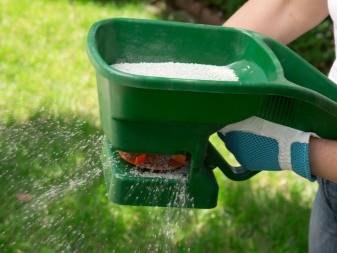
Restoration
It so happens that the lawn in the country has dried up or certain zones on the site have to be revived. In the first case, digging up the old lawn, you can sow the area with new grass, thus renewing the cover. Well, if the lawn turns yellow or there are dry spots, then the restoration work consists of proper feeding or in intensive care. You can reanimate by darning, that is, in those places where the grass has dried, repair the territory and plant a new lawn. Such work is relevant, for example, where there are bald spots. Strip the top layer, loosen the soil and sow the seeds in the desired area. Then mulch the soil with a thin layer of river sand (you can sprinkle it with compost) and tamp it.
For overseeding, it is important to select the same seed material as for the main sowing, that is, you need to select the same type of grass, it is better that the seed producer is the same. In areas where the grass cannot be replaced (severely damaged), remove the old surface and replace the damaged sod. Lawn holes can be repaired in several ways:
- replace with new pieces of grass from a roll;
- dig bushes of grass from other areas and transplant to the right place;
- sowing new seeds of the same type of grass.
In the spring, under favorable weather conditions, the seeds will germinate within a week, and the voids will quickly fill with greenery. If you covered a newly sown area with compost from above, “comb” it with a fan rake for evenness and do not forget about watering.If you properly restore the lawn, then after a while you will see how evenly your coverage turns green. Well, if you do nothing when you find problematic moments, then it will not be an hour long when you will lose the entire lawn. The restoration will not take you much time and effort, so do this process if necessary.
Please also note that irregularities may appear on the lawn during the winter. Fill these cavities with soil and make sure that grass grows on them, otherwise, sow them with seeds.
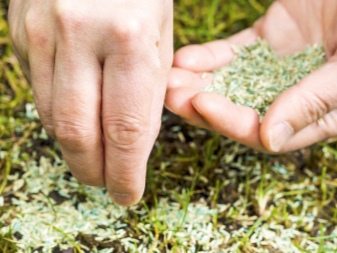
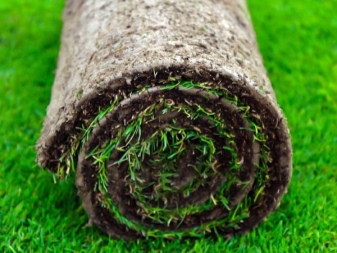
Watering
If weather conditions do not bring the required amount of moisture into the soil in spring, it is imperative to water the lawn during this period. Since the sun begins to warm the ground more and more, it is not recommended to water the lawn during the day, the grass can be simply burned. And the percentage of evaporation is also high, so the efficiency from daily irrigation is minimal.
In the evening, it is also undesirable to water, this is fraught with oversaturation with moisture, which can lead to diseases or the appearance of a fungus. The best time to moisturize the lawn is early in the morning (before 10:00). It is important that no puddles of water remain on the lawn after irrigation.
Moisten the soil at about 13-15 centimeters. You can check it simply: take any pointed object in the form of a stick and stick it into the soil. If it is tight to the indicated depth, then continue watering.
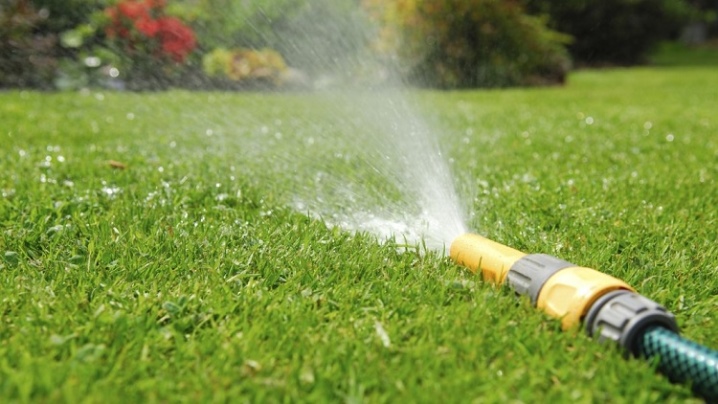
Weed control and shearing
At the beginning of the new season, it is important to start weed control on time. The sooner you get down to this business, the more guarantees that they will not grow, will not have time to give seeds and spread. The most effective way is to manually pluck the weeds along with the root system. But if there is a lot of weed on the site, or the lawn is large and there is no way to handle everything with your hands, then special chemicals (herbicides) are used to get rid of the weeds. Most often, you have to carry out treatment against chamomile, dandelion, plantain.
Usually they try to pull them out by hand or remove the tips during the next mowing of the lawn. If you notice unpleasant spots created by mold or fungus, you must immediately treat these places with fungicidal preparations. Moss in the garden is becoming a serious problem. It appears due to various reasons: shaded lawn, improper mowing, increased soil acidity and others. It is quite difficult to deal with moss, but it must be done, otherwise it will fill the entire space, including buildings.
It will instantly weaken not only the lawn grass, if the moss spreads, it will negatively affect all the plants in the garden. Usually, dolomite flour is used against the spread of moss, which is introduced into the soil. It is advisable immediately, as soon as the first foci are noticed, to process these places with this composition. And if its serious spread is allowed, you will have to treat the site with chemicals, here you cannot cope without them.
In dry weather, the lawn is treated with products that contain ammonium sulfate or copper.

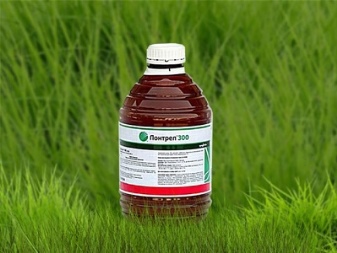
As the moss turns black, it is removed from the cover. And in order to prevent its re-spread, you need to regularly comb out the lawn, carry out aeration, regular feeding and not cut the cover too short. By the way, the first mowing is done when the grass reaches 10 centimeters, it is cut in half. The first haircut is important, it affects the growth density, increasing it, which has a positive effect on the quality of the green canvas. How short you cut your lawn - there is no such clear norm, it depends on the type of grass planted and your preferences.
The rate of overgrowth also depends on the type of lawn. By the way, Mowing stimulates the growth of the grass and maintains a beautiful lawn, so it is also a must-have for lawn maintenance. Mowing is done with special equipment.It is necessary to ensure that the blades of the technique are sharp, otherwise you will get a torn surface. And remember that the grass is cut only when the cover is dry and in the evening. Wet grass will clog the mower and result in an uneven cut.
So if you want to have a beautiful emerald green lawn, start proper maintenance from the beginning of spring.
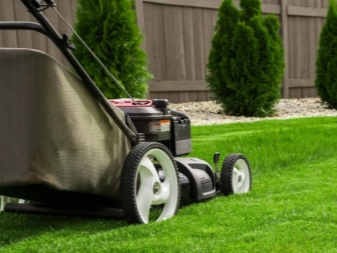
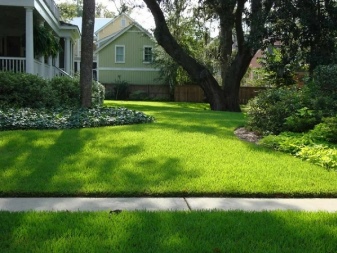
For information on how to properly care for your lawn in spring, see the next video.



































































The comment was sent successfully.